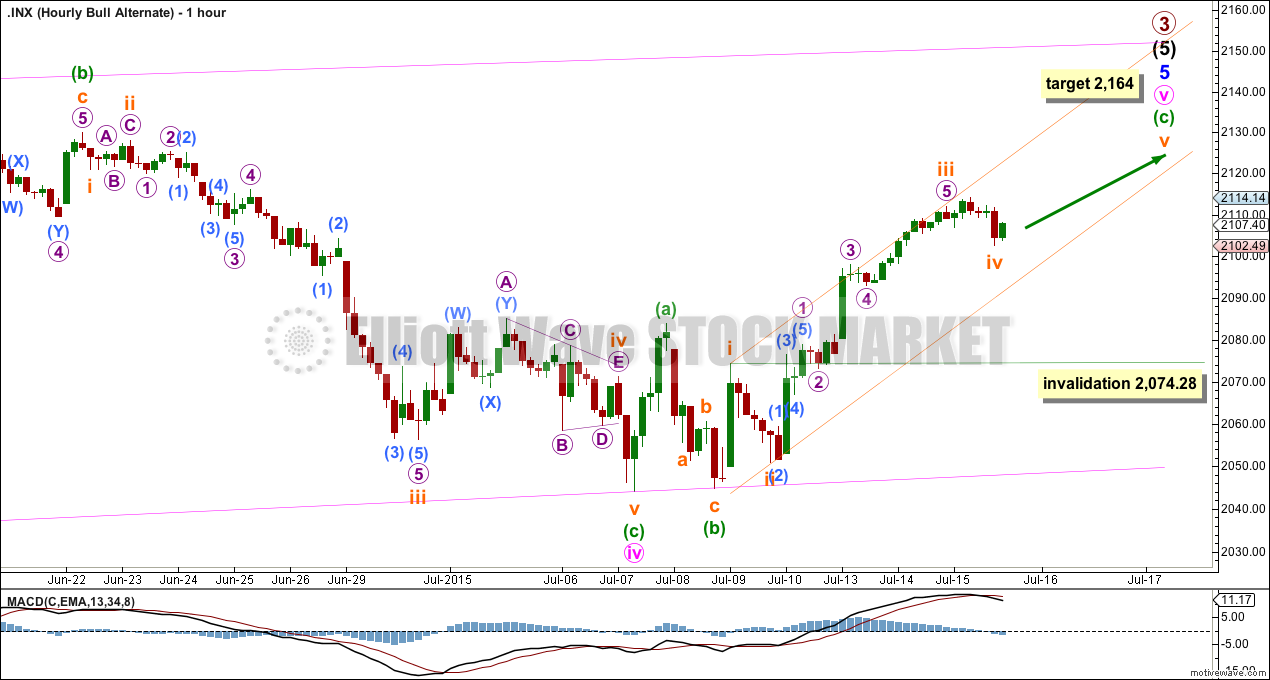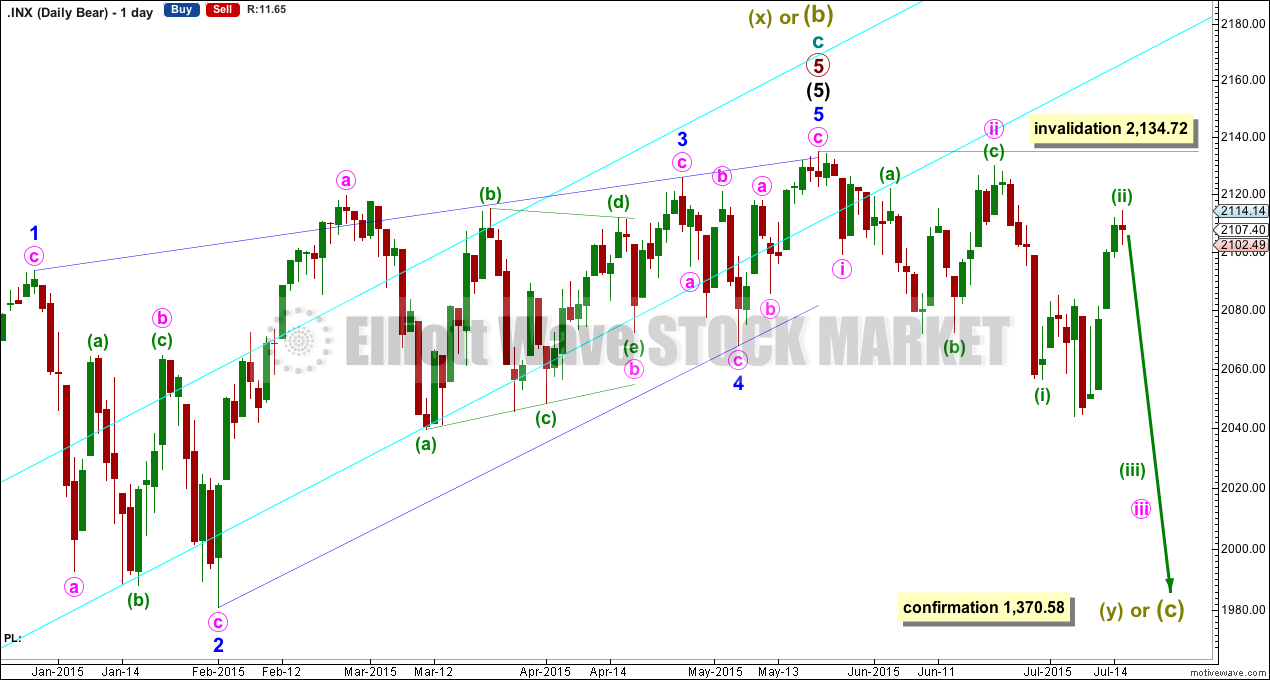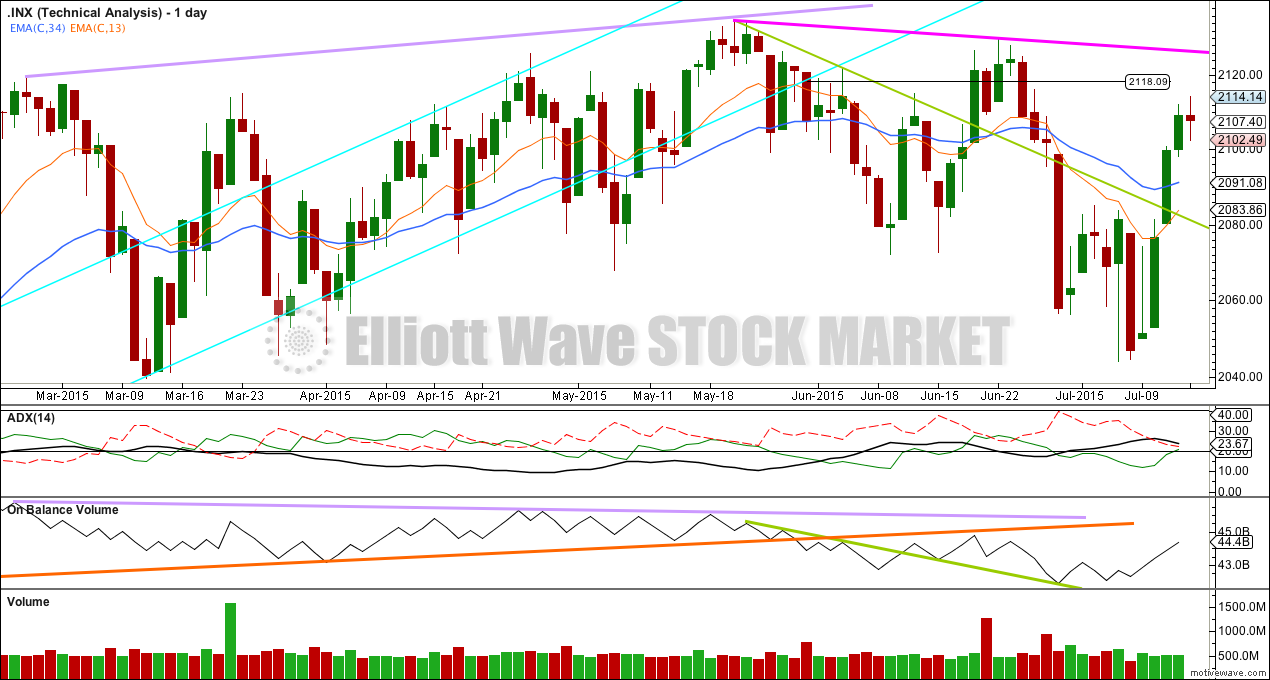Wednesday completed a small red candlestick after moving a little higher.
Downwards movement has clearly breached the channel on the hourly chart.
Summary: A third wave within a third wave down should begin from here to 1,995 or 1,922.
Changes to last analysis are bold.
To see a weekly chart and how to draw trend lines click here.
MAIN ELLIOTT WAVE COUNT
It is possible that the S&P has seen a primary degree (or for the bear count below a Super Cycle degree) trend change.
This wave count now has some confirmation at the daily chart level with a close more than 3% of market value below the long held bull market trend line.
Further confirmation would come with:
1. A new low below 2,022.07 to invalidate the alternate wave count.
2. A clear five down on the hourly chart.
3. A clear five down on the daily chart.
4. A new low below 1,820.66.
5. A break below the 50 day SMA on the weekly chart.
As each condition is met the probability of a substantial trend change would increase.
At this stage, a trend change is looking somewhat likely so I’ll list points in its favour:
1. ADX is above 20 and rising, and the -DX line is above the +DX line indicating a new downwards trend.
2. The long held bull market trend line, the strongest piece of technical analysis on ALL charts, has been breached now by a close more than 3% of market value.
3. There is quadruple negative divergence between price and MACD on the weekly chart.
4. There is double negative divergence between price and MACD on the daily chart.
5. There is persistent and strong negative divergence between price and RSI on the monthly chart. The last time this happened was October 2007 and we all know what happened after that…
6. A long held bull trend line on On Balance Volume going back to October 2014 has been breached and is no longer providing support (orange line added to OBV on the TA chart below).
7. DJT has recently failed to confirm the continuation of a bull market. This does not indicate a bear market, but does indicate caution.
Primary wave 4 would be likely to end within the price territory of the fourth wave of one lesser degree: intermediate wave (4) has its price territory from 1,730 to 1,647.
Primary wave 4 would be likely to exhibit alternation to primary wave 2. Primary wave 2 was a 0.41 zigzag correction lasting 12 weeks, one short of a Fibonacci 13. Primary wave 4 may be more shallow than the 0.382 Fibonacci ratio, and may be a flat, combination or triangle, which are more time consuming structures than zigzags so it should be longer in duration than primary wave 2. Primary wave 4 may last a Fibonacci 21 weeks in total, 1.618 the duration of primary wave 2.
Finally, the small channel about subminuette wave c was breached first by sideways and slightly higher movement and eventually at the end of the session by downwards movement. A breach of this channel along with the small red candlestick for Wednesday’s session is reasonable confirmation that minuette wave (ii) should be over now.
At 1,995 minuette wave (iii) would reach 1.618 the length of minuette wave (i). If price keeps falling through this first target, or if when it gets there the structure is incomplete, then the next target is at 1,922 where minuette wave (iii) would reach 2.618 the length of minuette wave (i).
Along the way down upwards corrections should find resistance at the upper edge of the green base channel drawn about minuette waves (i) and (ii).
If minuette wave (ii) continues any higher, then it may not move beyond the start of minuette wave (i) above 2,129.87.
ALTERNATE ELLIOTT WAVE COUNT
The ending contracting diagonal may still be incomplete. Ending diagonals require all sub waves to subdivide as zigzags, and the fourth wave should overlap first wave price territory. It is Elliott wave convention to always draw the diagonal trend lines to indicate a diagonal structure is expected.
The diagonal trend lines are no longer clearly contracting and minuette wave (c) within minute wave iv now looks like a three where it should be a five. This reduces the probability of this wave count.
If it moves any lower, then minute wave iv may not be longer than equality in length with minute wave ii at 2,022.07. If it is over here, then minute wave v up also has a limit and may not be longer than equality with minute wave iii at 2,197.84.
The best way to see where and when upwards movement may end is the upper diagonal i-iii trend line. It is very likely to be overshot. Upwards movement may find resistance at the long held bull market trend line.
Because the long held bull market trend line has now been breached by a close more than 3% of market value below it, this wave count is now an alternate and a bear market is indicated.
Minute wave v must subdivide as a zigzag, and within it, minuette waves (a) and (b) are most likely now complete. Within minuette wave (c), subminuette waves i, ii and now iii may be complete. Subminuette wave iv may not move into subminuette wave i price territory below 2,074.28.
Subminuette wave iv is so far showing up on the daily chart as one small red candlestick. It may be over here, or it may yet move lower.
If it is over here, then at 2,164 subminuette wave v would reach equality in length with subminuette wave i.
BEAR ELLIOTT WAVE COUNT
The subdivisions within cycle waves a-b-c are seen in absolutely exactly the same way as primary waves 1-2-3 for the main wave count.
In line with recent Grand Super Cycle wave analysis, I have moved the degree of labelling for the bear wave count all up one degree.
This bear wave count expects a Super Cycle wave (c) to unfold downwards for a few years, and if it is a C wave it may be devastating. It may end well below 666.79.
However, if this wave down is a Super Cycle wave (y), then it may be a time consuming repeat of the last big flat correction with two market crashes within it, equivalent to the DotCom crash and the recent Global Financial Crisis, and it may take another 8-9 years to unfold sideways.
Within the new bear market, no second wave correction may move beyond the start of its first wave above 2,134.72.
TECHNICAL ANALYSIS
ADX now indicates there is no trend and that price is in a consolidation. ADX does tend to be a lagging indicator, and may only now be indicating the consolidation for the last ten days. The -DX line remains above the +DX line, a trend change from down to up is not indicated.
I cannot get volume data for Wednesday’s session on this data feed. Data from my other FXCM feed indicates an increase in volume for Wednesday. If this is correct, then it should come for a down day and may indicate the resumption of the downwards trend.
If tomorrow completes a red candlestick, then it may complete an evening Doji star pattern. If that happens, then I would have more confidence in the resumption of a downward trend, which would come after a clear upwards movement.
On Balance Volume has not made a new high above the last swing high, nor has price. There is no bullish divergence. OBV fits the wave count.
The shorter EMA is still below the longer EMA. An upward trend is not yet indicated.
A note on Dow Theory: for the bear wave count I would wait for Dow Theory to confirm a huge market crash. For that to be confirmed the following new lows are needed:
S&P500: 1,820.66
Nasdaq: 4,116.60
DJT: 7,700.49
DJIA: 15,855.12
At this time DJT is closest, but none of these indices have made new major swing lows yet.
This analysis is published about 06:17 p.m. EST.







Wow! Another 52 week low in UVXY and still no new highs. I have never seen such unbridled optimism. The coming decline should be a doozy…